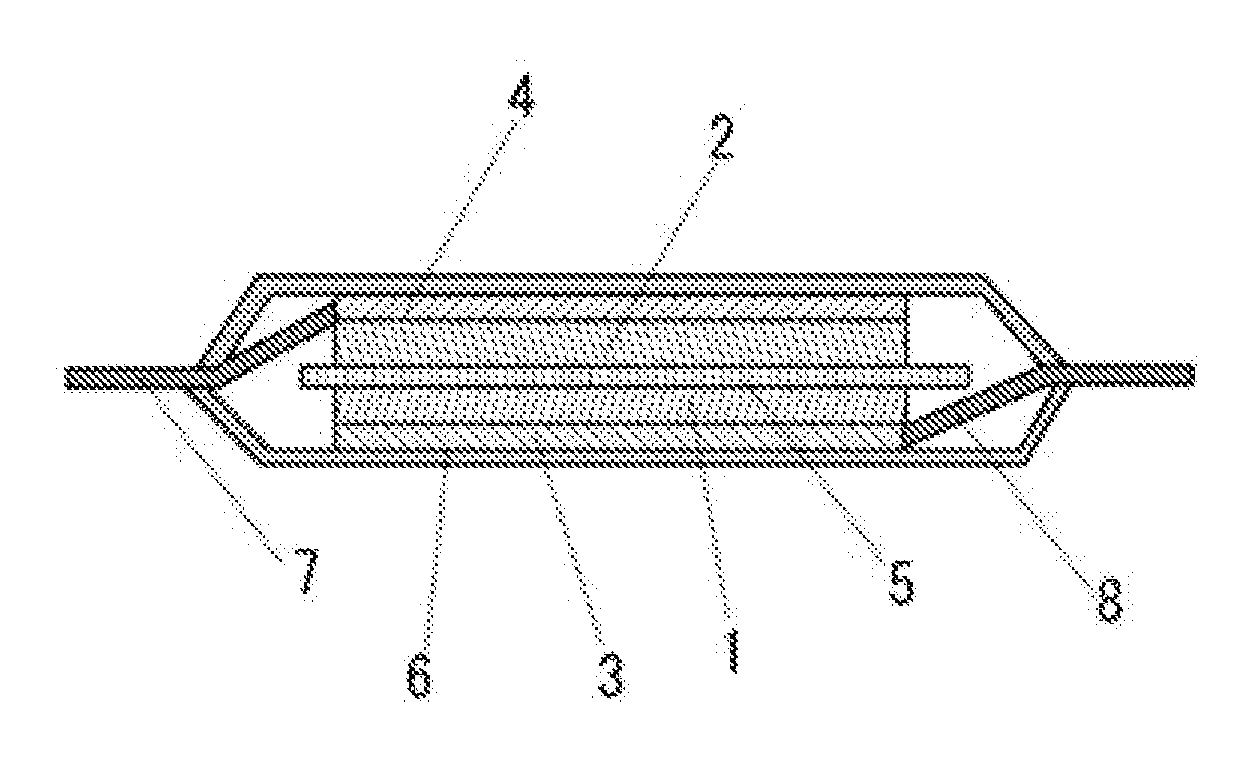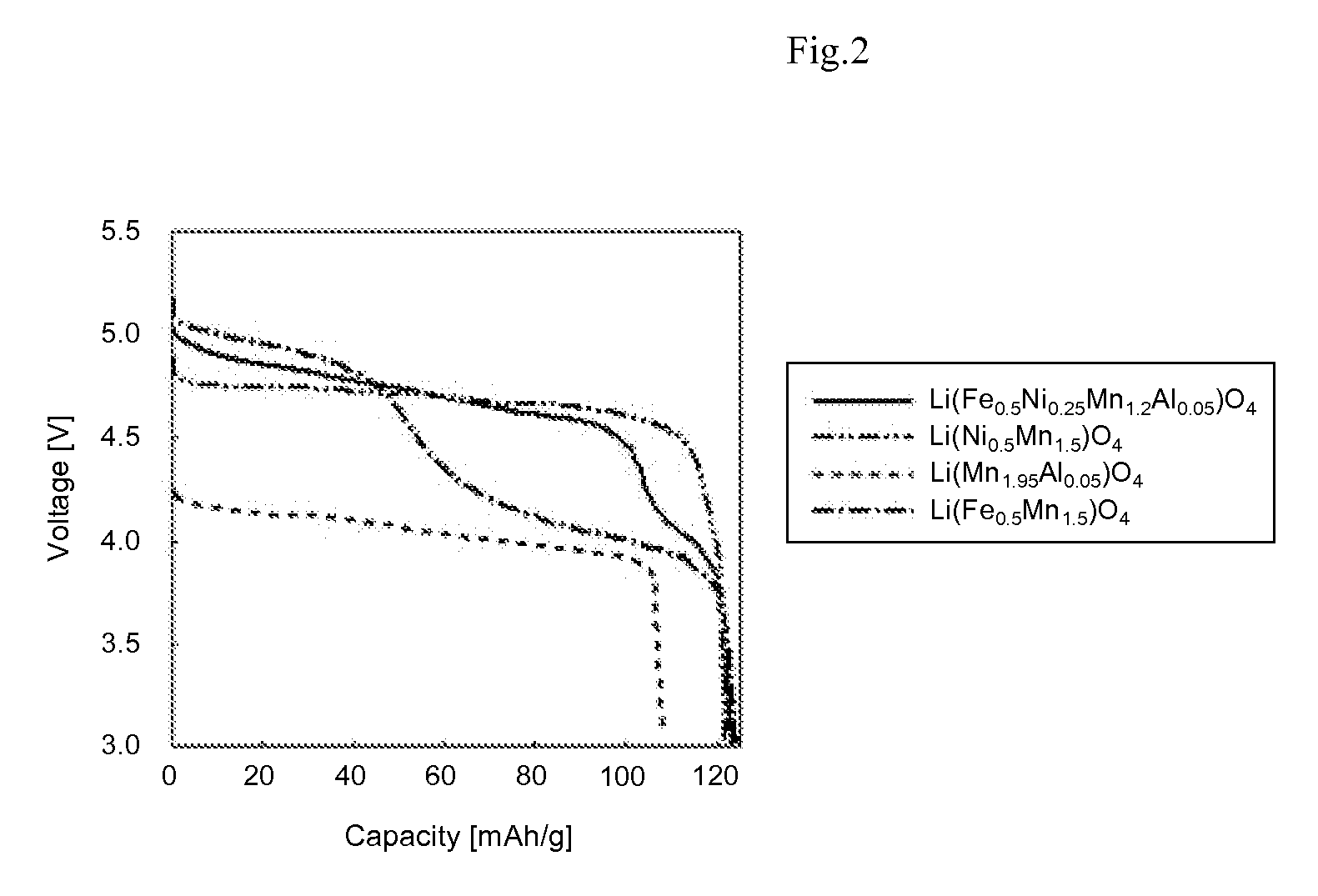Positive electrode active material for secondary battery and secondary battery using the same
a secondary battery and active material technology, applied in the direction of nickel compounds, non-metal conductors, sustainable manufacturing/processing, etc., can solve the problems of insufficient stoichiometry, uneven resource distribution, and high cost of co as a raw material, so as to increase the discharge energy and reduce the cos
- Summary
- Abstract
- Description
- Claims
- Application Information
AI Technical Summary
Benefits of technology
Problems solved by technology
Method used
Image
Examples
first exemplary embodiment
[0033]The positive electrode active material for a secondary battery according to the first aspect of the exemplary embodiment is represented by the following formula (I):
Lia(FexNiyMn2-x-y)O4 (I)
where 0.2
[0034]In the formula (I), the composition ratio x of Fe satisfies 0.2<x≦1.2. The case where x is 0.2 or less is not preferable in view of reducing cost and extending life. In contrast, if x exceeds 1.2, a crystal structure is destabilized and capacity drop occurs. This case is not preferable. In the formula (I), the composition ratio x of Fe is preferably 0.3<x≦1.0 and more preferably 0.4≦x≦0.8.
[0035]In the formula (I), the composition ratio y of Ni is 0
[003...
second exemplary embodiment
[0042]A positive electrode active material for a secondary battery according to the second aspect of the exemplary embodiment is represented by the following formula (II):
Lia(FexNiyMn2-x-y-zAz)O4 (II)
where 0.2≦x≦1.2, 0
[0043]In the formula (II), the composition ratio x of Fe is 0.2≦x≦1.2. The case where x is less than 0.2 is not preferable in view of reducing cost and extending life. In contrast, if x exceeds 1.2, a crystal structure is destabilized and capacity drop occurs. This case is not preferable. In the formula (II), the composition ratio x of Fe is preferably 0.3<x≦1.0 and more preferably 0.4≦x≦0.8.
[0044]In the formula (II), composition ratio y of Ni is 0
example 1
[0074]Raw materials for a positive electrode active material, MnO2, Fe2O3, NiO, Al2O3 and Li2CO3 were weighed so as to satisfy the metal composition ratio shown in Table 1, pulverized and mixed. The raw material powder mixture was baked at 800° C. for 8 hours to prepare a positive electrode active material.
[0075](Evaluation of Discharge Capacity and Average Discharge Voltage)
[0076]The positive electrode active material prepared and carbon (trade name: VGCF, manufactured by Showa Denko K. K.) serving as a conductivity imparting agent were mixed and dispersed in a solution having polyvinylidene fluoride (PVDF) serving as a binder dissolved in N-methylpyrrolidone to obtain slurry. The mass ratio of the positive electrode active material, conductivity imparting agent and binder was set at 92 / 4 / 4. Onto an Al collector, the slurry was applied. Thereafter, the slurry was dried in vacuum for 12 hours to obtain an electrode material. From the electrode material, a circle having a diameter of...
PUM
| Property | Measurement | Unit |
|---|---|---|
| energy density | aaaaa | aaaaa |
| size | aaaaa | aaaaa |
| composition | aaaaa | aaaaa |
Abstract
Description
Claims
Application Information
 Login to View More
Login to View More - R&D
- Intellectual Property
- Life Sciences
- Materials
- Tech Scout
- Unparalleled Data Quality
- Higher Quality Content
- 60% Fewer Hallucinations
Browse by: Latest US Patents, China's latest patents, Technical Efficacy Thesaurus, Application Domain, Technology Topic, Popular Technical Reports.
© 2025 PatSnap. All rights reserved.Legal|Privacy policy|Modern Slavery Act Transparency Statement|Sitemap|About US| Contact US: help@patsnap.com



